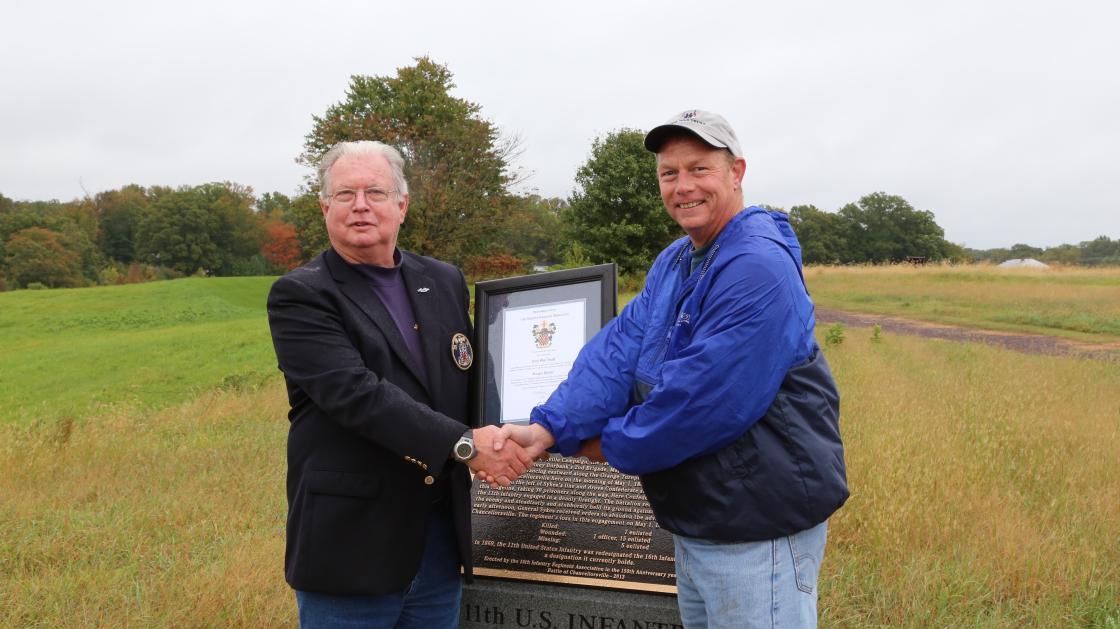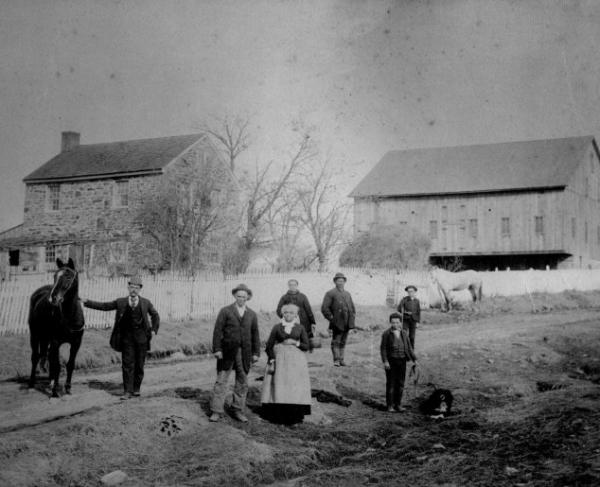
In the Wheatfield at Gettysburg, Omaha Beach at Normandy, Ramadi and Fallujah in Iraq and a host of deadly places in between, the 16th Infantry Regiment has established a record of service and sacrifice matched by few units of the U.S. Army.

For six or more generations, the foot soldiers of the 16th Infantry have distinguished themselves in the hard service of the common infantryman, fighting for ground often yard by yard while enduring the most punishing hardships conceived by man and nature.
The regiment came into being in the shock of the Confederate bombardment and occupation of Fort Sumter. On May 3, 1861, President Abraham Lincoln issued a proclamation calling for the creation of eight Federal regiments of infantry, one which became the 11th U.S. Infantry – today’s 16th Infantry Regiment.
The 11th U.S. Infantry fought at most of the war’s major Eastern Theater battles, including Gaines Mill, Malvern Hill, Second Bull Run, Antietam, Fredericksburg, Chancellorsville, the Wilderness, Spotsylvania, Cold Harbor, and the siege of Petersburg.
The unit was one of the first to enter action at Chancellorsville. On May 1, 1863, the men of the 11th U.S. Infantry engaged Confederate forces along the Orange Turnpike. The short, but fierce battle, cost the unit 28 officers and men. On the 150th anniversary of the battle, a monument to the unit was dedicated by the 16th Infantry Regiment Association, on land at Chancellorsville that was preserved by the American Battlefield Trust, as a lasting tribute to their fallen comrades.
At Gettysburg, the regiment marched out from the north face of Little Round Top on the battle’s second day to clash with Confederate Gen. James Longstreet’s attacking forces between Devil’s Den and the Wheatfield. The unit lost about half its men in the process. One witness lamented, “For two years the U.S. Regulars taught us how to be soldiers. In the Wheatfield at Gettysburg, they taught us how to die like soldiers.”

The first three of 11 Medals of Honor awarded to the regiment’s soldiers were from Civil War battles. Among the awardees was 1st Lt. John H. Patterson, cited for his bravery in the Wilderness on May 5, 1864, when he darted out under heavy fire to drag to safety a wounded officer who was in danger of being burned alive by the forest fire that consumed many other helplessly wounded men.
During the Army reorganization of 1869, a portion of the 11th United States Infantry was redesignated the 16th United States Infantry.
The "new" regiment’s service during the Indian Wars in the West included both chasing Geronimo in Arizona and after he was captured, providing the guards to escort him into captivity in Florida.
The unit saw extensive action during the Spanish-American War—fighting in 27 different engagements, including the capture of the famed San Juan Hill.
During the Philippines insurrection in 1900, Sgt. Henry F. Schroeder was awarded the regiment’s fourth Medal of Honor when he led a detachment of 24 men who defeated an attacking force of more than 300 insurgents.
In 1916, under the command of Gen. John J. “Black Jack” Pershing, the regiment chased Pancho Villa on a hot and dusty deployment in Mexico. Pershing was so impressed by the regiment; he personally decided that the 16th Infantry Regiment would be one of the four infantry regiments in the Army’s new 1st Division, the “Big Red One.”
The 16th was one of the first U.S. Army regiments to arrive in Europe in June 1917 to fight in World War I, with Pershing and other Americans paying homage on July 4, 1917, at the tomb of the Marquis de Lafayette, hero of the American Revolution, declaring, “Lafayette, we are here!”
The 16th Infantry became one of the first U.S. regiments bloodied in World War I when it repelled a German night raid in the trenches near Bathlemont on Nov. 3, 1917. A monument erected by the French government in Meurthe-et-Moselle honors the first three 16th Infantry soldiers killed in that battle.
The regiment went on to fight at Ansauville, Cantigny, Coullemelle, Soissons, and other battles. In the Meuse-Argonne Campaign, the 16th Infantry was the only regiment in the army to take its main objective on Oct. 4, 1918, the first day of its campaign. But the sacrifice was staggering. In 12 months of combat, the regiment lost 1,037 soldiers killed in action or mortally wounded, and 3,389 wounded. It came home with seven new campaign streamers and a new motto: “No mission too difficult, no sacrifice too great—Duty First!”
During World War II, the regiment lit the “Torch” in North Africa in 1942 and was part of “Operation Husky,” the Allied invasion of Sicily. On June 6, 1944, the 16th Infantry was one of the regiments ordered to take Omaha Beach during “Operation Overlord,” better known as D-Day. Of the five D-Day landing beaches, Omaha Beach was the deadliest—survivors dubbed it “Bloody Omaha.” Hundreds of the regiment’s young infantrymen were mowed down, but by noon, the 16th had established a beachhead and seized the town of Colleville-sur-Mer.

At a ceremony on July 2, Allied commander Gen. Dwight D. Eisenhower told the regiment:
“I’m not going to make a long speech, but this simple little ceremony gives me an opportunity to come over here, and through you, say thanks. You are the finest regiment in our army. I know your record from the day you landed in North Africa, and through Sicily. I am beginning to think that your regiment is a sort of Praetorian Guard, which goes along with me and gives me luck.”
The 16th fought in the Battle of the Bulge and other battles during the liberation of Europe. In World War II, the unit lost 1,250 killed in action and 6,278 wounded or missing. Five soldiers were awarded the Medal of Honor, including two who fought and died on D-Day—John J. Pinder, Jr. and Jimmie W. Monteith, Jr.
In Vietnam, the regiment was at the forefront of the Big Red One’s service. The unit saw extended service in Vietnam from 1965 to 1970, at places such as the Michelin Rubber Plantation, the Iron Triangle, the Trapezoid and Hobo Woods became well known to young infantrymen of a new generation. They too served in one of the largest campaigns of the war, the 1968 Tet Offensive. Two of the regiment’s bravest were awarded Medals of Honor—James W. Robinson, Jr. and Matthew Leonard—both medals were awarded posthumously. Platoon Sergeant Leonard was the first African-American soldier awarded the Medal of Honor from the 16th U.S. Infantry.
In Operation Desert Storm, the 16th played a major role in the fight to retake Kuwait and joined a massive armored assault into Iraq on Feb. 24, 1991, which included a huge battle two days later against Saddam Hussein’s Republican Guard that destroyed more than 40 Iraqi tanks. In recent years, the regiment has been deployed several times to Iraq, including the western cities of Fallujah and Ramadi, and in 2011 was deployed to Afghanistan.
The venerable 16th Infantry Regiment is stationed at Fort Riley, Kansas. The 16th Infantry Regiment Association, formed in 1990, manages an array of services and activities that include an annual reunion, this year on July 26-30 in Kansas City, Mo.

Help raise the $429,500 to save nearly 210 acres of hallowed ground in Virginia. Any contribution you are able to make will be multiplied by a factor...
Related Battles
17,304
13,460
6,800
8,700
2,100
5,600
14,462
7,387
12,401
10,316
12,500
6,000
8,150
3,236
23,049
28,063
17,000
13,000
12,737
4,595


